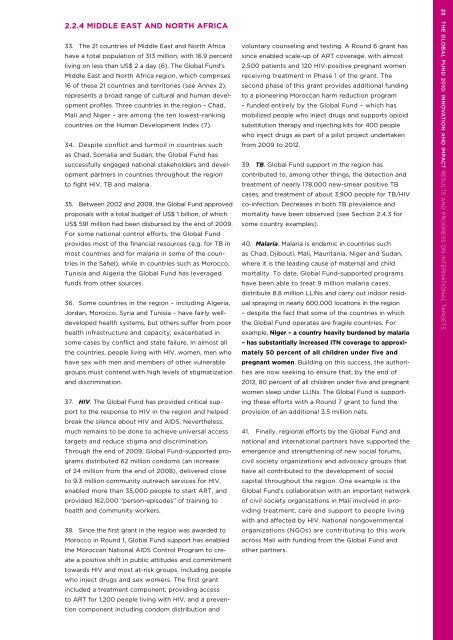Global Fund: Progress Report 2010 - unaids
Global Fund: Progress Report 2010 - unaids
Global Fund: Progress Report 2010 - unaids
Create successful ePaper yourself
Turn your PDF publications into a flip-book with our unique Google optimized e-Paper software.
2.2.4 mIddLE EAST ANd North AfrICA<br />
33. The 21 countries of Middle East and North Africa<br />
have a total population of 313 million, with 16.9 percent<br />
living on less than US$ 2 a day (6). The <strong>Global</strong> <strong>Fund</strong>’s<br />
Middle East and North Africa region, which comprises<br />
16 of these 21 countries and territories (see Annex 2),<br />
represents a broad range of cultural and human development<br />
profiles. Three countries in the region – Chad,<br />
Mali and Niger – are among the ten lowest-ranking<br />
countries on the Human Development Index (7).<br />
34. Despite conflict and turmoil in countries such<br />
as Chad, Somalia and Sudan, the <strong>Global</strong> <strong>Fund</strong> has<br />
successfully engaged national stakeholders and development<br />
partners in countries throughout the region<br />
to fight HIV, TB and malaria.<br />
35. Between 2002 and 2009, the <strong>Global</strong> <strong>Fund</strong> ap proved<br />
proposals with a total budget of US$ 1 billion, of which<br />
US$ 591 million had been disbursed by the end of 2009.<br />
For some national control efforts, the <strong>Global</strong> <strong>Fund</strong><br />
provides most of the financial resources (e.g. for TB in<br />
most countries and for malaria in some of the countries<br />
in the Sahel), while in countries such as Morocco,<br />
Tunisia and Algeria the <strong>Global</strong> <strong>Fund</strong> has leveraged<br />
funds from other sources.<br />
36. Some countries in the region – including Algeria,<br />
Jordan, Morocco, Syria and Tunisia – have fairly welldeveloped<br />
health systems, but others suffer from poor<br />
health infrastructure and capacity, exacerbated in<br />
some cases by conflict and state failure. In almost all<br />
the countries, people living with HIV, women, men who<br />
have sex with men and members of other vulnerable<br />
groups must contend with high levels of stigmatization<br />
and discrimination.<br />
37. HIV. The <strong>Global</strong> <strong>Fund</strong> has provided critical support<br />
to the response to HIV in the region and helped<br />
break the silence about HIV and AIDS. Nevertheless,<br />
much remains to be done to achieve universal access<br />
targets and reduce stigma and discrimination.<br />
Through the end of 2009, <strong>Global</strong> <strong>Fund</strong>-supported programs<br />
distributed 62 million condoms (an increase<br />
of 24 million from the end of 2008), delivered close<br />
to 9.3 million community outreach services for HIV,<br />
enabled more than 35,000 people to start ART, and<br />
provided 162,000 “person-episodes” of training to<br />
health and community workers.<br />
38. Since the first grant in the region was awarded to<br />
Morocco in Round 1, <strong>Global</strong> <strong>Fund</strong> support has enabled<br />
the Moroccan National AIDS Control Program to create<br />
a positive shift in public attitudes and commitment<br />
towards HIV and most at-risk groups, including people<br />
who inject drugs and sex workers. The first grant<br />
included a treatment component, providing access<br />
to ART for 1,200 people living with HIV, and a prevention<br />
component including condom distribution and<br />
voluntary counseling and testing. A Round 6 grant has<br />
since enabled scale-up of ART coverage, with almost<br />
2,500 patients and 120 HIV-positive pregnant women<br />
receiving treatment in Phase 1 of the grant. The<br />
second phase of this grant provides additional funding<br />
to a pioneering Moroccan harm reduction program<br />
– funded entirely by the <strong>Global</strong> <strong>Fund</strong> – which has<br />
mobilized people who inject drugs and supports opioid<br />
substitution therapy and injecting kits for 400 people<br />
who inject drugs as part of a pilot project undertaken<br />
from 2009 to 2012.<br />
39. TB. <strong>Global</strong> <strong>Fund</strong> support in the region has<br />
contributed to, among other things, the detection and<br />
treatment of nearly 178,000 new-smear positive TB<br />
cases, and treatment of about 3,900 people for TB/HIV<br />
co-infection. Decreases in both TB prevalence and<br />
mortality have been observed (see Section 2.4.3 for<br />
some country examples).<br />
40. Malaria. Malaria is endemic in countries such<br />
as Chad, Djibouti, Mali, Mauritania, Niger and Sudan,<br />
where it is the leading cause of maternal and child<br />
mortality. To date, <strong>Global</strong> <strong>Fund</strong>-supported programs<br />
have been able to treat 9 million malaria cases,<br />
distribute 8.8 million LLINs and carry out indoor residual<br />
spraying in nearly 600,000 locations in the region<br />
– despite the fact that some of the countries in which<br />
the <strong>Global</strong> <strong>Fund</strong> operates are fragile countries. For<br />
example, Niger – a country heavily burdened by malaria<br />
– has substantially increased ITN coverage to approximately<br />
50 percent of all children under five and<br />
pregnant women. Building on this success, the authorities<br />
are now seeking to ensure that, by the end of<br />
2012, 80 percent of all children under five and pregnant<br />
women sleep under LLINs. The <strong>Global</strong> <strong>Fund</strong> is supporting<br />
these efforts with a Round 7 grant to fund the<br />
provision of an additional 3.5 million nets.<br />
41. Finally, regional efforts by the <strong>Global</strong> <strong>Fund</strong> and<br />
national and international partners have supported the<br />
emergence and strengthening of new social forums,<br />
civil society organizations and advocacy groups that<br />
have all contributed to the development of social<br />
capital throughout the region. One example is the<br />
<strong>Global</strong> <strong>Fund</strong>’s collaboration with an important network<br />
of civil society organizations in Mali involved in providing<br />
treatment, care and support to people living<br />
with and affected by HIV. National nongovernmental<br />
organizations (NGOs) are contributing to this work<br />
across Mali with funding from the <strong>Global</strong> <strong>Fund</strong> and<br />
other partners.<br />
23 THE GLOBAL FUND <strong>2010</strong>: INNOVATION AND IMPACT results aND progress ON internatiONal targets

















